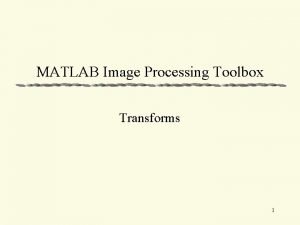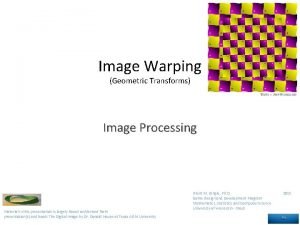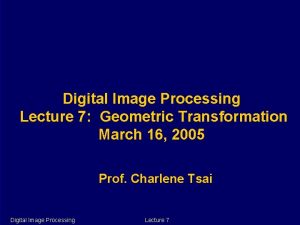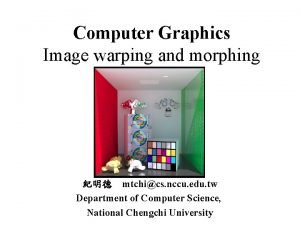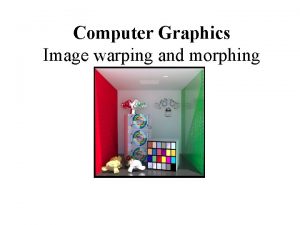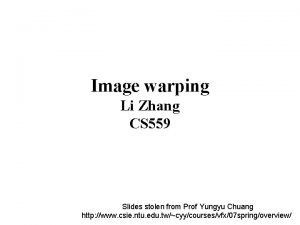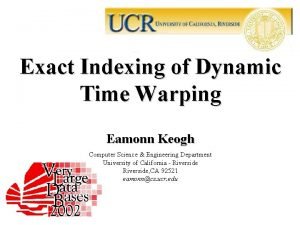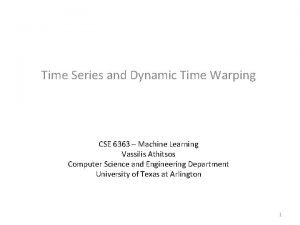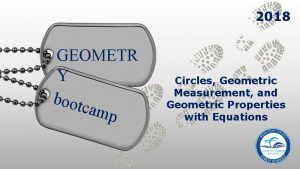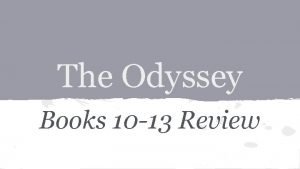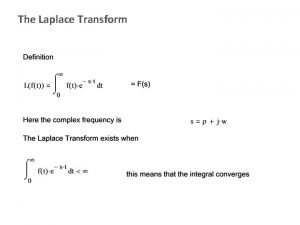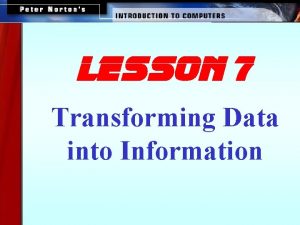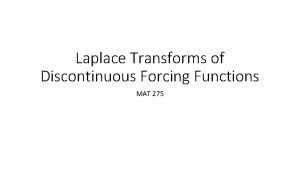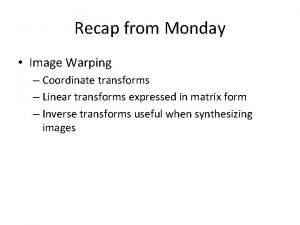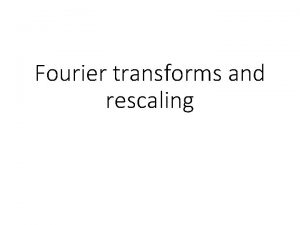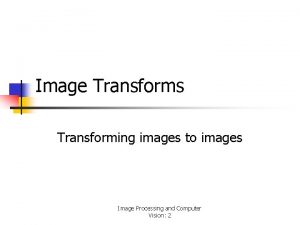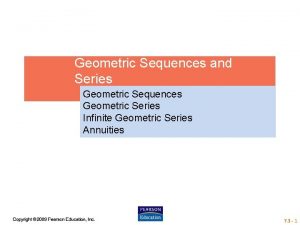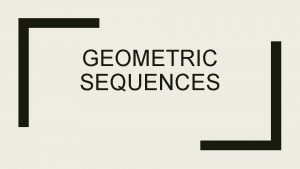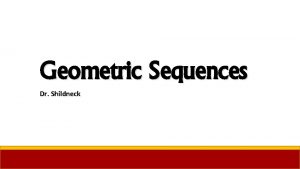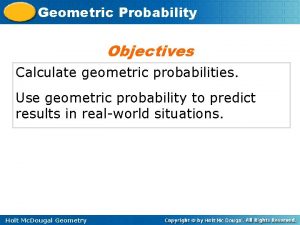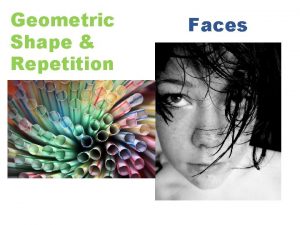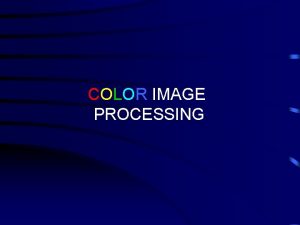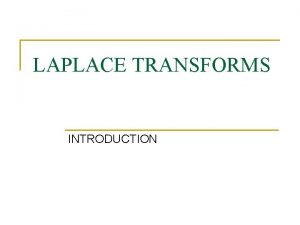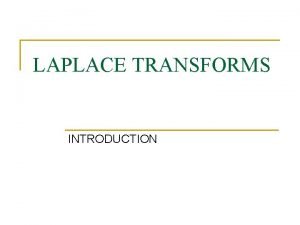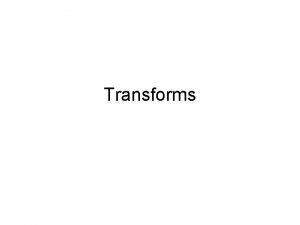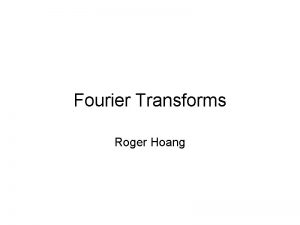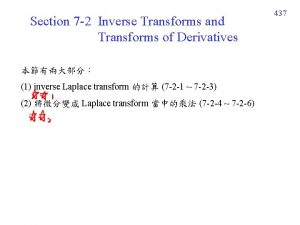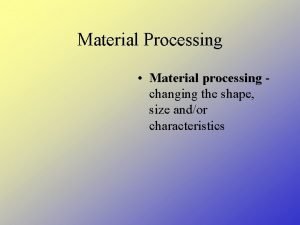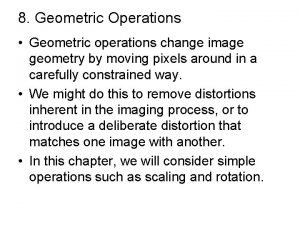Image Warping Geometric Transforms Image Processing Material in





![Forward Mapping: [ X(), Y() ] • If the image was continuous and the Forward Mapping: [ X(), Y() ] • If the image was continuous and the](https://slidetodoc.com/presentation_image/318892a485adee5771191860d27289b6/image-6.jpg)


![Searching for a Solution [ X(), Y() ] Could try weighting average of some Searching for a Solution [ X(), Y() ] Could try weighting average of some](https://slidetodoc.com/presentation_image/318892a485adee5771191860d27289b6/image-9.jpg)


![Inverse Map: [ U(), V() ] • Recall the forward map: • Invert the Inverse Map: [ U(), V() ] • Recall the forward map: • Invert the](https://slidetodoc.com/presentation_image/318892a485adee5771191860d27289b6/image-12.jpg)























- Slides: 35

Image Warping (Geometric Transforms) Image Processing Material in this presentation is largely based on/derived from presentation(s) and book: The Digital Image by Dr. Donald House at Texas A&M University Brent M. Dingle, Ph. D. Game Design and Development Program Mathematics, Statistics and Computer Science University of Wisconsin - Stout 2015

Lecture Objectives • Previously – Image Interpolation • Today – Image Warping (Geometric Transforms)

Outline • Warping (Geometric Transforms) – General Image Warps – Forward and Inverse Mapping

Apples of All Shapes and Sizes

Image Warps • Mapping and functions X() and Y() map (u, v) to (x, y) in vector notation:
![Forward Mapping X Y If the image was continuous and the Forward Mapping: [ X(), Y() ] • If the image was continuous and the](https://slidetodoc.com/presentation_image/318892a485adee5771191860d27289b6/image-6.jpg)
Forward Mapping: [ X(), Y() ] • If the image was continuous and the forward map: [X(), Y()] is relatively smooth (no discontinuities) – Then for each old image pixel (u, v) we can paint new pixel (x, y) using the same color

Forward Map • Digital image are NOT continuous – They consist of a finite number of samples = pixels – Allowing the following algorithm to perform a mapping ( x , y ) original image’s pixel color at (u, v)

Problem with Forward Map • With loss of “continuous/infinite” points – one-to-on mapping cannot happen – forward map leaves holes and folds ? = hole in new image = fold in new image scaled up on this side scaled down on this side
![Searching for a Solution X Y Could try weighting average of some Searching for a Solution [ X(), Y() ] Could try weighting average of some](https://slidetodoc.com/presentation_image/318892a485adee5771191860d27289b6/image-9.jpg)
Searching for a Solution [ X(), Y() ] Could try weighting average of some kind to mix colors, to fill holes and fix folds…

Still Searching… • If map is to curvy lines/edges that averaging becomes more difficult – not very “pixel-to-pixel” [ X(), Y() ] Must be an easier way…

Inverse Map Solution • Invert the problem – Look at each output pixel and determine what input pixel(s) map to it • instead of sending each input pixel to an output pixel No holes or folds !!!
![Inverse Map U V Recall the forward map Invert the Inverse Map: [ U(), V() ] • Recall the forward map: • Invert the](https://slidetodoc.com/presentation_image/318892a485adee5771191860d27289b6/image-12.jpg)
Inverse Map: [ U(), V() ] • Recall the forward map: • Invert the mapping functions X() and Y() or in matrix form:

Inverse Mapping Algorithm ( u , v ) The inverse map provides a complete covering

Forward vs Inverse Maps Forward Map: ( x , y ) Inverse Map: ( u , v )

Inverse Supports Clipping Too! Warping and clipping all together, same time

Inverse Supports Clipping Too! A forward map would map this pixel to the new image and require it to be cleared off later

Affine Map • A geometric transformation that maps points and parallel lines to points and parallel lines • General form of an affine map: aij are coefficient constants

Affine Maps: Matrix Form in matrix form looks like:

What about Infinity? • Euclidean/Cartesian space cannot handle points at infinity cannot describe projective space The railroad tracks become narrower as they meet the horizon parallel lines intersect at infinity Projective space allows for this effect AND Image from: http: //www. songho. ca/math/homogeneous. html It is easy to transform points to and from Cartesian space into and out of Projective space …

Homogeneous Coordinate System • Every (Cartesian) point has an identical third coordinate NOTE: Conversion from Cartesian coordinates to Homogeneous coordinates is unique however, Conversion from Homogeneous coordinates to Cartesian is NOT unique Image from: http: //www. cs. mtu. edu/~shene/COURSES/cs 3621/NOTES/geometry/homo-coor. html

Homogeneous Coordinate System • Every (Cartesian) point has an identical third coordinate ( u, v, 1) ( x, y ) Affine will focus on the plane defined by w=1 Image will be (u, v, 1) with u and v the pixel coordinates NOTE: Conversion from Cartesian coordinates to Homogeneous coordinates is unique however, Conversion from Homogeneous coordinates to Cartesian is NOT unique Image from: http: //www. cs. mtu. edu/~shene/COURSES/cs 3621/NOTES/geometry/homo-coor. html

Matrix Translation • Given homogeneous coordinates (u, v, 1) – Find Cartesian coordinates (x, y) Explicitly, x then would be calculated as: AGAIN: Conversion from Homogeneous coordinates to Cartesian is NOT unique coeffs aij will describe how we want to warp an image, Example: a 13 is a translation distance for x

Points to Remember • Homogeneous Coordinates – allow affine transformations to be easily represented by matrix multiplications • Affine Maps – always have an inverse – can be represented in matrix form (via homogeneous coords)

Scale: an affine map transform • scale(x, y) = ( a 11 u, a 22 v )

Translate: an affine map transform • translate (x, y) = ( u + a 13, v + a 23 ) (a 13, a 23) (0, 0)

Shear: an affine map transform • shear (x, y) = ( u + a 12 v, a 21 u + v) a 12 v a 21 u

Rotate: an affine map transform • (0, 0) NOTE: rotation is around (0, 0)… which might not achieve the expected result

Composing Affine Warps • R is a rotation • S is a scale • T is a translation First do a rotation, followed by a scale, then a translation Denote this as: By associative property can also denote it as:

Composing Affine Warps • All translations, scales, and rotations can be done using one matrix • Yields ONE SIMPLE representation – Important: order of operations when creating the matrix does matter, be careful – i. e. operations are NOT commutative

Example

T and S Commutative ? • What is ST ? NOT commutative !

Summary: Warps • Warps are cool • Homogeneous coordinates are cool – Can represent affine warps in one “matrix way” • Affine warps are awesome – Can combine warps into one matrix – BUT order matters

Questions? • Beyond D 2 L – Examples and information can be found online at: • http: //docdingle. com/teaching/cs. html • Continue to more stuff as needed

Extra Reference Stuff Follows

Credits • Much of the content derived/based on slides for use with the book: – Digital Image Processing, Gonzalez and Woods • Some layout and presentation style derived/based on presentations by – – – – Donald House, Texas A&M University, 1999 Bernd Girod, Stanford University, 2007 Shreekanth Mandayam, Rowan University, 2009 Igor Aizenberg, TAMUT, 2013 Xin Li, WVU, 2014 George Wolberg, City College of New York, 2015 Yao Wang and Zhu Liu, NYU-Poly, 2015 Sinisa Todorovic, Oregon State, 2015
 Digital image processing
Digital image processing Matlab dctmtx
Matlab dctmtx Affine image warping
Affine image warping Geometric transformation in digital image processing
Geometric transformation in digital image processing Image processing lecture
Image processing lecture Image transforms
Image transforms Point processing operations
Point processing operations Fractal image
Fractal image Histogram processing in digital image processing
Histogram processing in digital image processing Neighborhood processing in digital image processing
Neighborhood processing in digital image processing Point processing
Point processing Morphological processing in digital image processing
Morphological processing in digital image processing Amber
Amber Amber
Amber Animation warping
Animation warping Eamonn keogh
Eamonn keogh Morphing
Morphing Eamonn keogh
Eamonn keogh Dynamic time warping stock market
Dynamic time warping stock market Frequency warping in dsp
Frequency warping in dsp Dynamic time warping
Dynamic time warping Circles geometric measurement and geometric properties
Circles geometric measurement and geometric properties Image transform in digital image processing
Image transform in digital image processing Noise
Noise Arithmetic coding in digital image processing
Arithmetic coding in digital image processing Key stages in digital image processing
Key stages in digital image processing Error free compression
Error free compression Image sharpening and restoration
Image sharpening and restoration The range of values spanned by the gray scale is called:
The range of values spanned by the gray scale is called: Maketform matlab
Maketform matlab Image restoration in digital image processing
Image restoration in digital image processing What does tiresias warn odysseus not to do?
What does tiresias warn odysseus not to do? Laplace transform.table
Laplace transform.table The unit that transforms data into information is the
The unit that transforms data into information is the Asu
Asu Walang sugat setting
Walang sugat setting

